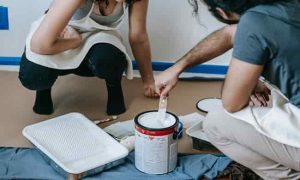Most sprayer guns work efficiently with most viscosity materials but latex. Since latex paint is quite thick, it has the propensity to clog the pain gun. Therefore, to make it compatible to use, you need to thin out latex paint first.
The more you know about the paint features, the better you can deal with it without damaging the paint gun. For those who are struggling with latex paint to spray with the paint sprayer, I have decided to show them how to thin latex paint for sprayer with a step-by-step guide.
Here we go!
What Is Latex Paint?
The characteristics of paints are divided into two categories. One is water-based, which uses water as the medium. And the other one is oil-based or alkyd paint which is based on petroleum. Of these two, latex is a water-based paint.
Compared with other paints, the viscosity of latex is very thick. This is why, when the paint passes through the paint sprayer nozzle, it tends to clog the nozzle tip. Also, such paint requires so much pressure to pass. Hence, only certain spray guns are suitable to atomize latex paint easily.
If your spray gun is not made for latex, Don’t worry! Using water or thinner is the best way to thin latex paint beforehand for your spray gun. All you need to be aware of is to ensure the thinner and paint ratio to bring the right viscosity before application.
How to Thin Latex Paint for Spray Gun?
Thinning latex paint for a sprayer might sound like a complicated job. However, if you have the right materials in hand, you can easily master the process with a few attempts of practice. Here are the materials you need to arrange first.
Tools you will need
- A Cordless drill
- Metal spiral power mixer
- Paint stirring stick (wooden)
- Nitrile gloves
- Bucket
- Measuring cup
- Fine mesh cone strainer or funnel
Materials
- Latex paint
- Water
Step 1: Adjust the Paint Temperature
Before you begin the process of how to thin out latex paint, wear a pair of nitrile gloves to protect your hands.
Now, in the first step, it’s important to bring the paint to room temperature. It would help if you acclimated it between 50 and 90 degrees Fahrenheit. Because usually, cold paint tends to be less thick and flow smoothly. Hence, it doesn’t require thinning. Therefore, it’s important to adjust the paint in the ambient room.

Step 2: Stir the Paint
Before thinning out the paint, you need to pre-mix it. Generally, the solid material of the paint tends to rest at the bottom over time. Hence, it becomes difficult to determine the actual consistency of the paint. For this reason, you need to mix the paint properly so that all materials are mixed together. To do this, you need to attach the power mixer to the drill and mix the paint.
Then, using the wooden paint stirring stick, you need to test if the pre-mix is done properly. As you stir the stick, if it drags towards the bottom, the paint mixing isn’t done yet. Run the drill again to ensure the same consistency throughout.
Step 3: Assess the Paint Thickness
As the mixing is done, you need to carefully check the paint thickness. Because the paint sprayers require a certain viscosity of the material so that they can effectively atomize the paint. Therefore, you need to assess the viscosity of the paint after the pre-mixing step.
For this step, you can use a viscosity cup, funnel, or a wooden stick. If you have the wooden stick, dip it into the paint and lift it off the paint container. Hold it there for a while. If the paint is flowing freely and has a smooth and creamy consistency, then it doesn’t require to thin out. However, if you notice the paint is dripping off slowly and doesn’t drain properly, then it needs to be thinned out.
Step 4: Strain the Paint
Before adding a thinner, you need to filter the paint to remove the chunks and films. If you can visualize the large pieces in the paint, remove them using the hook end of the can opener. Then, pour the paint using the strainer to remove the remaining impurities.
Step 5: Thin out the Paint
Finally, you are at the actual step of thinning out the latex paint. How do you thin latex paint? Well, you can use water or paint thinner. However, for this step, I am going to show you how to thin paint with water.
To bring the correct viscosity of the paint, you need to ensure the correct volume of water. Hence, using a fluid measuring cup, measure 4 ounces of room temperature water. For reference, you can always check the paint can or read through the paint specifications online.
Step 6: Mix Paint with Water
To mix the paint with water, you need to pour the paint into a bucket. Choose the bucket size according to the paint volume and project type. Then, pour the paint into the bucket.
Now, you can add water to latex paint slowly in one hand and gently keep stirring with the wooden paint stick with the other hand. Here, start slowly and gradually add water. Because if you pour water all at once, then the paint will become too thin and unable to be used.
Step 7: Test the Viscosity
Again test the viscosity of the newly thinned paint. Take the wooden stirring stick, dip in and hold it over the bucket. Usually, right after holding the stick, it should drain freely. Add more water if needed.
Final Thought
So, now you know how to thin latex paint. Before you use it with the spray gun, always test the paint on scrap cardboard. Apply and allow it to dry to observe the final outcome.
